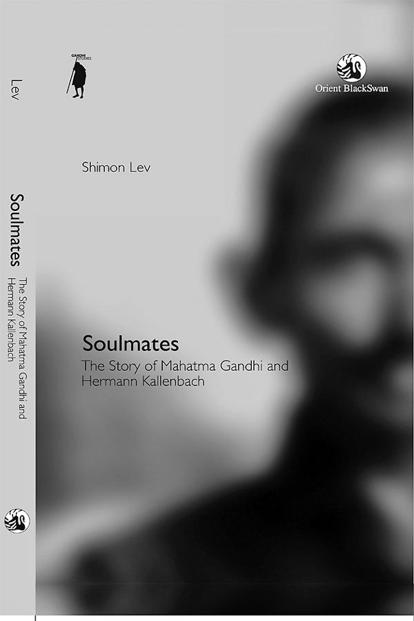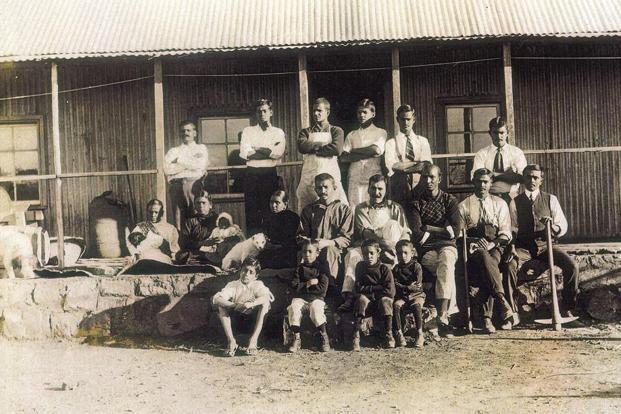In 2015, a statue commemorating the friendship of Mahatma Gandhi and Jewish architect Hermann Kallenbach was unveiled near a synagogue in Rusnė, Lithuania. This friendship was an important part of the Mahatma’s time in South Africa. Kallenbach used his considerable resources to help Gandhi set up the Tolstoy Farm community in Transvaal, South Africa, in 1910, becoming an ardent early supporter of his experiments with satyagraha.
Israeli multidisciplinary artist Shimon Lev has documented this relationship in his book Soulmates: The Story Of Mahatma Gandhi And Hermann Kallenbach, published in 2012. Lev argues that Gandhi began the transition to the Mahatma during the years spent at the Tolstoy Farm. Meanwhile, Kallenbach immersed himself in Gandhian philosophy, following its moral and political cues through the satyagraha movement in South Africa.
Lev’s study of this personal, cultural and political encounter, mapping the growth of Gandhi and Kallenbach’s belief systems on to their respective national movements, throws new light on a vital period of 20th century history. Lounge caught up with Shimon Lev on the sidelines of the Tata Literature Live! litfest in Mumbai in November. Edited excerpts:

How did you discover the Kallenbach archive?
Though I was already pursuing Indian studies, my knowledge of Gandhi was not extensive. A strange coincidence led to the Kallenbach archive. I was writing a series of articles as I followed a hiking trail across Israel. As I reached Kibbutz Degania Alef, near the Sea of Galilee, I visited the cemetery and chanced upon the grave of Hermann Kallenbach. In the piece I filed, I wrote a few lines based on whatever I knew about Kallenbach back then. Two weeks later, I got a call from Isa Sarid, the daughter of Kallenbach’s niece, who invited me to Haifa to see an entire archive dedicated to him.
I was amazed. This tiny room was packed with files and most bore the name Gandhi. One of the first files that caught my eye carried the name Tolstoy Farm. Kallenbach’s niece Hanna Lazar had brought the archive from South Africa. In that very first meeting, I knew that this material was going to make a book.
The archive comprised Kallenbach’s correspondence with Gandhi and other close associates, original glass-plate photos of the time spent on Tolstoy Farm, official documents from the period, Kallenbach’s architectural drawings, material related to Zionism from Kallenbach’s visit to Palestine in 1936-37, and his endeavour to spread the Zionist cause in India.
The discovery of this archive in Israel pointed to an entire missing chapter in Gandhi’s biography. I took (writer-historian) Ramachandra Guha to the archive and he brought the Indian ambassador. This started the Indian government’s negotiation with the family to buy this archive. It was eventually purchased for the sum of $1.2 million (around Rs7.6 crore now) in 2012 and placed in the National Archive in Delhi.
How does the Gandhian notion of non-violence fit with the discourse of Zionism? What was Gandhi’s reaction to the persecution of Jews during World War II?
It is well-known that Gandhi was opposed to Zionism at first. But there are two parts of Kallenbach and Gandhi’s relationship. First, they were friends in South Africa. The second part is when Zionist officials enlisted Kallenbach to travel to India and change Gandhi’s perception of Zionism. While Gandhi objected to Zionism, Kallenbach was able to modify his view. By 1939, he accepted the rights of the Jews and sympathized with their suffering. The issue was complicated in the light of the communal tensions between Hindus and Muslims.
During World War II, things changed quite dramatically. The Holocaust left Kallenbach quite torn as, on the one hand, he believed in non-violence, while on the other, Hitler represented a kind of evil that no one had experienced before. Gandhi’s attitude to the Holocaust is quite a controversial issue, because a lot of people said that he just couldn’t understand what was going on in Germany. While Gandhi’s idea of non-violence might have worked in South Africa or against the British, the same could not be said of the Nazis, as they lacked all humanity and would have destroyed you.
How do you deal with an extreme case like the Holocaust, where all value for life was done away with, where there wasn’t any possibility of a Jewish leadership? The big question is why Gandhi maintained such a silence after the Holocaust. I wonder whether his silence pointed to his realization that non-violence could not work in the context of Hitler and Germany.
What did Tolstoy Farm represent to both Gandhi and Kallenbach?
Tolstoy Farm was founded in 1910, by which time Gandhi had already conceptualized ideas that he would develop in India. In Transvaal, he first put in practice the social, moral, religious components of his doctrine. Tolstoy Farm became the subject of research for different kinds of cooperative communities across the world. Kallenbach was by his side through this period. He was rich and used his money to buy the land and help set up the farm. Both he and Gandhi often referred to the time that he spent in Tolstoy Farm as among the happiest in their lives. Together, they were fulfilling a shared vision of a social, moral way of life.

How does your work as a Gandhi scholar feed into your work as an artist?
One of my ongoing projects is called the Two Family Archives, where I have been working with an Austrian artist, Friedemann Derschmidt, whose family has a Nazi history, while my grandparents were killed during the Holocaust. My father was pretty much the only one who survived the camps. This terrible event is a part of my life.
Had I not studied Gandhi, I would not be able to undertake this project or enable this dialogue with someone I once perceived as my enemy. Derschmidt is my age and obviously not a Nazi and has been very brave about confronting his family and bringing out their association with the Nazis and SS (Schutzstaffel). To see personal details of Nazi lives was part of a process of understanding as well as creating something new for both of us.
Tell us a bit about the role of truth in the nation-building narrative, in both India as well as Israel.
I feel that a true scholar—whether that is a historian or anyone else—is one who is honest with himself. His real aim is to search for some kind of truth and knowledge. Both in Israel and India, rewriting history is a very big issue and I think it is the historian’s job to see through the layers to arrive at the real narrative, vis-à-vis the official or one determined by political parties.
It has been 70 years since Mahatma Gandhi’s assassination. Do you think the narrative around Gandhi has changed in that time, especially in Israel?
After the Holocaust, Jewish public opinion was against him, based on his opposition to Zionism and his advice for the Jews to adopt satyagraha as a way of dealing with the Nazis. The general population regarded him as a great man but also one who was irrelevant in Israel’s context. Only a small group of pacifists looked towards Gandhi for inspiration. Over the last two decades, though, relations have warmed between the two countries. Gandhi represents a more global perspective and his philosophy is relevant across commerce, ecology, dialogues between nations and peace talks. There is a newer openness towards Gandhi. People are looking at much more than just his relationship to Zionism.


























